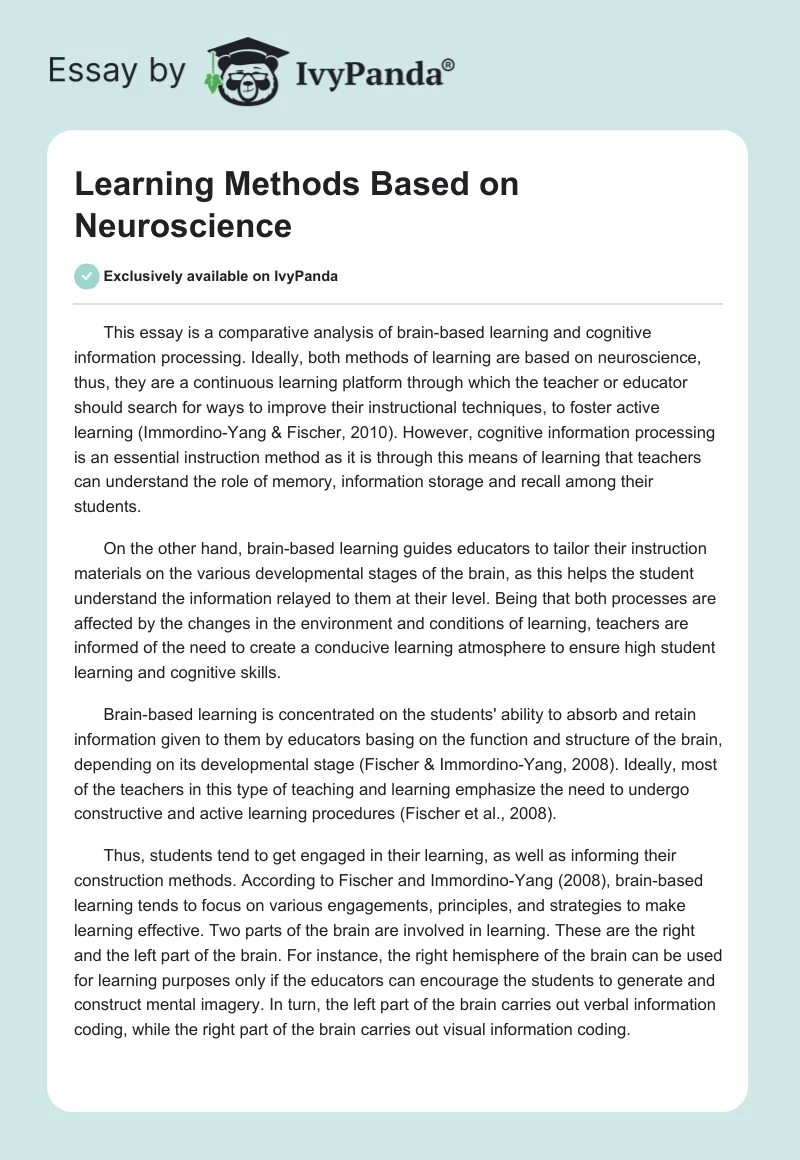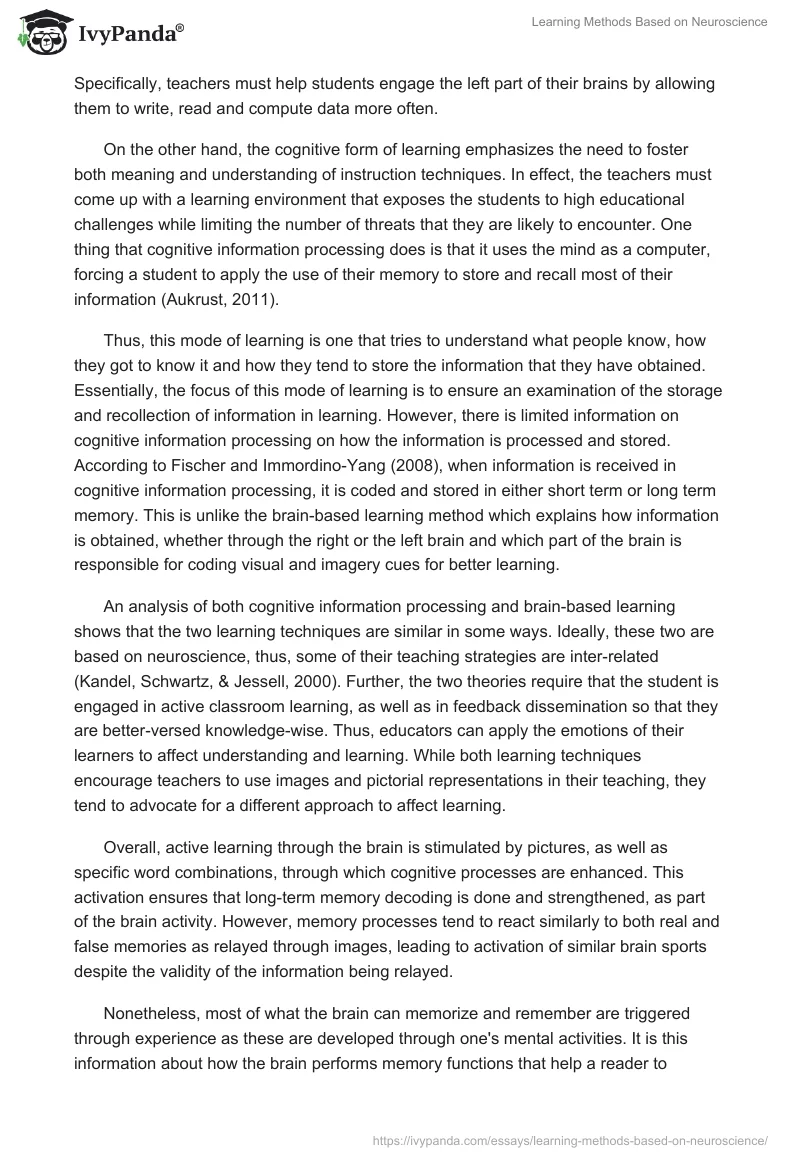This essay is a comparative analysis of brain-based learning and cognitive information processing. Ideally, both methods of learning are based on neuroscience, thus, they are a continuous learning platform through which the teacher or educator should search for ways to improve their instructional techniques, to foster active learning (Immordino-Yang & Fischer, 2010). However, cognitive information processing is an essential instruction method as it is through this means of learning that teachers can understand the role of memory, information storage and recall among their students.
On the other hand, brain-based learning guides educators to tailor their instruction materials on the various developmental stages of the brain, as this helps the student understand the information relayed to them at their level. Being that both processes are affected by the changes in the environment and conditions of learning, teachers are informed of the need to create a conducive learning atmosphere to ensure high student learning and cognitive skills.
Brain-based learning is concentrated on the students’ ability to absorb and retain information given to them by educators basing on the function and structure of the brain, depending on its developmental stage (Fischer & Immordino-Yang, 2008). Ideally, most of the teachers in this type of teaching and learning emphasize the need to undergo constructive and active learning procedures (Fischer et al., 2008).
Thus, students tend to get engaged in their learning, as well as informing their construction methods. According to Fischer and Immordino-Yang (2008), brain-based learning tends to focus on various engagements, principles, and strategies to make learning effective. Two parts of the brain are involved in learning. These are the right and the left part of the brain. For instance, the right hemisphere of the brain can be used for learning purposes only if the educators can encourage the students to generate and construct mental imagery. In turn, the left part of the brain carries out verbal information coding, while the right part of the brain carries out visual information coding. Specifically, teachers must help students engage the left part of their brains by allowing them to write, read and compute data more often.
On the other hand, the cognitive form of learning emphasizes the need to foster both meaning and understanding of instruction techniques. In effect, the teachers must come up with a learning environment that exposes the students to high educational challenges while limiting the number of threats that they are likely to encounter. One thing that cognitive information processing does is that it uses the mind as a computer, forcing a student to apply the use of their memory to store and recall most of their information (Aukrust, 2011).
Thus, this mode of learning is one that tries to understand what people know, how they got to know it and how they tend to store the information that they have obtained. Essentially, the focus of this mode of learning is to ensure an examination of the storage and recollection of information in learning. However, there is limited information on cognitive information processing on how the information is processed and stored. According to Fischer and Immordino-Yang (2008), when information is received in cognitive information processing, it is coded and stored in either short term or long term memory. This is unlike the brain-based learning method which explains how information is obtained, whether through the right or the left brain and which part of the brain is responsible for coding visual and imagery cues for better learning.
An analysis of both cognitive information processing and brain-based learning shows that the two learning techniques are similar in some ways. Ideally, these two are based on neuroscience, thus, some of their teaching strategies are inter-related (Kandel, Schwartz, & Jessell, 2000). Further, the two theories require that the student is engaged in active classroom learning, as well as in feedback dissemination so that they are better-versed knowledge-wise. Thus, educators can apply the emotions of their learners to affect understanding and learning. While both learning techniques encourage teachers to use images and pictorial representations in their teaching, they tend to advocate for a different approach to affect learning.
Overall, active learning through the brain is stimulated by pictures, as well as specific word combinations, through which cognitive processes are enhanced. This activation ensures that long-term memory decoding is done and strengthened, as part of the brain activity. However, memory processes tend to react similarly to both real and false memories as relayed through images, leading to activation of similar brain sports despite the validity of the information being relayed.
Nonetheless, most of what the brain can memorize and remember are triggered through experience as these are developed through one’s mental activities. It is this information about how the brain performs memory functions that help a reader to understand the brain-based learning process. In effect, I am inclined to believe that brain-based learning is an active learning-based method as compared to cognitive information processing. It is through the explanation of how brain memory functions that an instructor can understand the learning level of the student, as well as tailor instructional materials to correspond to their level of thinking. Thus, understanding the developmental structure of the student as per the function of their brain at a given age is key to understanding the kind of information they are likely to comprehend quickly. In return, this fosters positive student engagement and learning.
References
Aukrust, V. G. (Ed.). (2011). Learning and cognition. New York, NY: Elsevier. Web.
Fischer, K. W. Fischer, K. W., & Immordino-Yang, M. H. (2008). The fundamental importance of the brain and learning for education. In the Jossey-Bass reader on the brain and learning. San Francisco, CA: Jossey-Bass. Web.
Fischer, K., & Immordino-Yang, M. H. (2008). The Jossey-Bass reader on the brain and learning. San Fransisco, CA: Jossey –Bass. Web.
Immordino-Yang, M. H., & Fischer, K. W. (2010). Neuroscience bases of learning. International Encyclopedia of Education (3rd ed.). Oxford: Elsevier. Web.
Kandel, E. R., Schwartz, J. H., & Jessell, T. M. (Eds.). (2000). Principles of neural science. New York, NY: McGraw-hill. Web.


